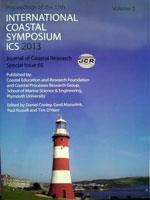Shin, S., Lee, K.-H., Kim, D.-S., Kim, K.-H., and Hong, K., 2013. A study on the optimal shape of wave energy conversion system using an oscillating water column
With the intention of diversifying energy sources, the use of natural and renewable energy sources such as sunlight, wind, tides, geothermal heats and waves is attracting favorable attention. Furthermore, current environmental issues, including global warming, ozone depletion and nuclear problems, promote development of renewable energy technologies. Many renewable energy technologies are however still under progress. Among these, the wave energy conversion system using an oscillating water column (OWC) is nearing commercial stage. OWC use the air flow induced by the vertical motion of water column in the air chamber as a driving force of turbine. Although it is well known that OWC is one of the most efficient devices to harness wave power, there is still much uncertainty about the relationship between the optimal shape and its hydrodynamic performance under the confined wave conditions. In this study, we propose a new computational fluid dynamics solver using on the immiscible two-phase (gas and water) flow model to simulate an OWC system in a two and three dimensional numerical wave tank. The numerical experiments focus on air flow velocity directly related to the working of turbine to survey the optimal shape. In order to validate the developed numerical model, laboratory experiments for the simplified OWC are carried out in a wave tank under regular wave conditions. The comparisons between the results of the developed numerical model and experimental data reveal a favorable agreement between the air flow velocity as well as the water surface profiles. Based on the validated numerical model, the effects of the inlet and chamber shapes including length, height, width and slope on the maximum air flow velocity are numerically investigated. As a result, in case the non-dimensional chamber width normalized by the incident wave length is in the range of 0.12 to 0.43, the maximum air flow velocity occurs with the increase of the inlet height and shortness of the inlet length.





